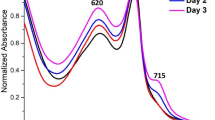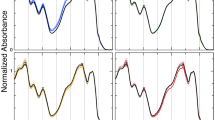Abstract
A profile of high light to intense self-shading conditions was constructed using a white light source and cultures of the cyanobacterium Synechococcus 6301; this profile approximates to a natural self-shading gradient of decreasing light intensity and PS II/PS I excitation ratio. Samples of S.6301 were placed along this profile and allowed to state adapt. To separate the effects of light intensity and wavelength on state adaptation, samples were also placed in a shade profile produced by a white light source and neutral density filters. After adaptation, samples were fixed in their resulting state by the addition of glutaraldehyde, and fluorescence measurements were made at 35° C or –160 °C. It is concluded:
-
1.
Under conditions of deep shade (<5 μmol m−2s−1 PAR) and weak shade (>200 μmol m−2s−1 PAR), cells adapt to a low PS II fluorescence state (state 2); in moderate shade (20–60 μmol m−2s−1PAR) cells adapt to a high PS II fluorescence state (state 1). We suggest these findings provide evidence for the operation of different factors on the control of state adaptations in cyanobacteria; one set operates at low light and another at high light intensities.
-
2.
Under conditions of self-shading, there is little evidence to support the contention that state adaptations in cyanobacteria are produced by wavelength-dependent changes in the PS II/PS I excitation ratio, instead, it appaers they are produced by changes in the intensity of incident irradiation.
-
3.
The observed fluorescence changes do not appear to involve major changes in the phycobilisome sensitisation of PS II and PS I. Instead, it appears that these changes are effected by alterations in ΦF of PS II (i.e. changes in PS II excitation density caused by alterations in the rate constants controlling spillover to PS I, photochemistry, fluorescence emission or thermal deactivation.
Similar content being viewed by others
References
Allen JF (1992) Protein phosphorylation in regulation of photosynthesis. Biochim Biophys Acta 1098: 275–335
Allen JF, Sanders CE and Holmes NG (1985) Correlation of membrane protein phosphorylation with excitation energy distribution in the cyanobacterium Synechococcus 6301. FEBS Lett 193: 271–275.
Biggins J and Bruce D (1985) Mechanism of the light state transition in photosynthesis III. Kinetics of the state transition in Porphyridium cruentum. Biochim Biophys Acta 806: 230–236
Biggins J, Campbell CL and Bruce D (1984) Mechanism of the light state transition in photosynthesis. II. Analysis of phosphorylated polypeptides in the red algae Porphyridium cruentum. Biochim Biophys Acta 767: 138
Bonaventura C and Myers J (1969) Fluorescence and oxygen evolution from Chlorella pyrenoidosa. Biochim Biophys Acta 189: 366
Bruce D and Salehian O (1992) Laser-induced optoacoustic calorimetry of cyanobacteria. The efficiency of primary photosynthetic processes in state 1 and state 2. Biochim Biophys Acta 1100: 242–250
Bruce D, Biggins J, Steiner T and Thewalt (1985) Mechanism of the light state transition in photosynthesis. IV. Picosecond fluorescence spectroscopy of Anacystis nidulans and Porphyridium cruentum in state 1 and state 2 at 77K. Biochim Biophys Acta 806: 237–246.
Bruce D, Brimble S and Bryant D (1989) State transitions in a phycobilisom-less mutant of the cyanobacterium Synechococcus sp. PCC 7002. Biochim Biophys Acta 974: 66–73.
Catt M, Saito K and Williams WP (1984) Excitation energy distribution in green algae: The existence of two independent light-driven control mechanisms. Biochim Biophys Acta 767: 39–47
Eeng X and Melis A (1986) Phosphorylation of the light-harvesting complex II in higher plant chloroplast. Effect on Photosystem II and Photosystem I absorption cross-section. Photobiochem Photobiophys 13: 41–52
Dominy PJ and Williams WP (1987) The role of respiratory electron flow in the control of excitation energy distribution in the bluegreen algae. Biochim Biophys Acta 892: 264–274.
Fork DC and Satoh K (1983) State 1-state 2 transitions in the thermophilic blue-green algae (Cyanobactrium) Synechococcus lividus. Photobiochem Photobiol 37 (4): 421–427
Gantt E (1986) Phycobilisomes. In: Staehelin LA and Arntzen CJ (eds) Encyclopedia of Plant Physiology, Vol III, pp 260–267. Springer-Verlag, Berlin
Harrison MA, Keen JN, Findlay JBC and Allen JF (1990) Modification of the glnB-like gene product by photosynthetic electron transport in the cyanobacterium Synechococcus 6301. FEBS Lett 264: 25–28
Harrison MA, Tsinoremas NF and Allen JF (1991) Cyanobacterial thylakoid membrane proteins are reversibly phosphorylated under plastoquinone-reducing conditions in vitro. FEBS Lett 282: 295–299
Haworth P and Melis A (1983) Phosphorylation of chloroplast thylakoid membrane proteins does not increase the absorption cross-section of Photosystem I. FEBS Lett 160: 277–280
Horton P and Black MT (1981) Light-induced Redox changes in chloroplast cytochrome f after phosphorylation of membrane proteins. FEBS Lett 132: 75–77
Islam K (1989) GTP-induced chloroplast membrane protein phosphorylation and Photosystem II fluorescence changes: Evidence for multiple protein kinase activities. Biochim Biophys Acta 974: 261–266
Islam K and Jennings RC (1985) Relative kinetics of quenching of Photosystem II fluorescence and phosphorylation of the two light-harvesting chlorophyll a/b polypetides in isolated spinach thylakoids. Biochim Biophys Acta 810: 158–163
Kitajima M and Butler WL (1975) Energy transfer between Photosystem II and Photosystem I in chloroplasts. Biochim Biophys Acta 396: 72–85
Kohorn BD and Yakir D (1990) Movement of newly imported light-harvesting chlorophyll-binding protein from unstacked to stacked thylakoid membranes is not affected by light treatment or absence of amino-terminal threonines. J Biol Chem 265: 2118–2123
Kratz WA and Myers J (1955) Nutrition and growth of several bluegreen algae. Am J Bot. 42: 282–287
Malkin S, Herbert SK and Fork DC (1990) Light distribution, transfer and utilization in the marine red alga Porphyra perforata from photoacoustic energy-storage measurements. Biochim Biophys Acta 1016: 177–189
Markwell JP, Baker NR and Thornber JP (1984) Use of zinc ions to study thylakoid proteins phosphorylation and the state 1-state 2 transition in vitro. Plant Physiol 74: 348–354
Mullineaux CW (1992) Excitation energy transfer from the phycobilisomes to PS I in a cyanobacterium. Biochim Biophys Acta 1100: 285–292
Mullineaux CW and Allen JF (1986) The state 2 transition in the cyanobactrium Synechococcus 6301 can be driven by respiratory electron flow into the plastoquinone pool. FEBS Lett 205 (1): 155–160
Mullineaux CW and Allen JF (1988) Fluorescence induction transients indicate dissociation of Photosystem II from the phycobilisome during the state 2 transition in the cyanobactium Synechococcus 6301. Biochim Biophys Acta 934: 96–107
Mullineaux CW and Holzwarth AR (1990) A proportion of Photosystem II core complex are decoupled from the phycobilisome in light state 2 in the cyanobacterium Synechococcus 6301. FEBS Lett 260: 245–248
Mullineaux CW and Holzwarth AR (1991) Kinetics of excitation energy transfer in the cyanobacterial phycobilisome-PS II complex. Biochim Biophys Acta 1098: 68–78
Mullinneaux CW, Bittersman E, Allen J and Holzwarth AR (1990) Picosecond time resolved fluorescence emission spectra indicate decreased energy transfer from the phycobilisome to Photosystem II in light — state 2 in the cyanobactrium Synechococcus 6301. Biochim Biophys Acta 1015: 231–242
Murata N (1969) Control of excitation transfer in photosynthesis. I. Light-induced change of chlorophyll a fluorescence in Porphyridium cruentum. Biochim Biophy Acta 172: 242–251
Salehian O and Bruce D (1992) Distribution of excitation energy in photosynthesis; quantification of fluorescence yields from intact cyanobacteria. J Luminescence 51: 91–98
Sanders CE and Allen JF (1989) Effects of divalent cations on 77 K fluorescence emission and on membrane protein phosphorylation in isolated thylakoids of the cyanobacterium Synechococcus 6301. Biochim Biophys Acta 934: 87–95
Sanders CE, Melis A and Allen JF (1989) In vivo phosphorylation of proteins in the cyanobacterium Synechococcus 6301 after chromatic acclimation of Photosystem I or Photosystem II light. Biochim Biophys Acta 976: 168–172
Schuster G, Owens GC, Cohen Y and Ohad I (1984) Thylakoid polypeptide compostion and light-independent phosphorylation of the chlorophyll a, b- protein in prochloron, a prokaryote exhibiting oxygenic photosynthesis. Biochim Biophys Acta 767: 596–605
Sinclair J and Cousineau C (1981) The effect of adenosine-5′-triphosphate on oxygen evolution, fluorescence emission and the emerson enhancement effect. FEBS Lett 136: 213–215
Williams WP and Dominy PJ (1990) Control of excitation energy distribution in cyanobacterea: Sensitivity to uncouplers and ATP synthase inhibitors. Biochim Biophys Acta 1015: 121–130
Williams WP and Salamon Z (1976) Enhancement studies on algae and isolated chloroplasts. Part I. Variability of photosynthetic enhancement in Chlorella pyrenoidosa. Biochim Biophys Acta 430: 282–299
Author information
Authors and Affiliations
Rights and permissions
About this article
Cite this article
Rouag, D., Dominy, P. State adaptations in the cyanobacterium Synechcoccus 6301 (PCC): Dependence on light intensity or spectral composition?. Photosynth Res 40, 107–117 (1994). https://doi.org/10.1007/BF00019049
Received:
Accepted:
Issue Date:
DOI: https://doi.org/10.1007/BF00019049




